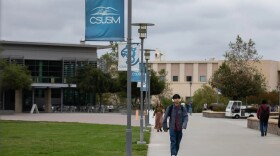Speaker 1: (00:00)
Even as hospitals across the region, struggle with a huge swell in patients, signs are emerging that staffing shortages are beginning to improve. And while hospitalization rates have not yet reached the highs of last winter, the ongoing crush of patients as testing the resources of San Diego's emergency departments. Joining me now with more a is San Diego union Tribune health reporter, Paul Sissen.
Speaker 2: (00:23)
Paul. Welcome. Thanks so much for having me. So what's the
Speaker 1: (00:26)
Latest with hospitalizations across the county. We're
Speaker 2: (00:29)
Up to just a little over 1300 in the weekly report that comes out every Wednesday from the county. That's still, uh, you know, significantly below the Heights that we saw last year. I think the number got up just over 1800, uh, when it was at its worst. Uh, last January, you know, this is interesting because, uh, last week, uh, we had some forecasting and projections from a, a really good researcher at U C S D. And that research indicated that it might go higher than it did last year. That just the massive, larger number of infections that we've seen in the last couple weeks would produce a larger number, even though the, the hospitalization rate is much lower than it was with Aron. I guess the, uh, the idea was that because the denominator is so much larger, the numerator would eventually end up exceeding last year. So, so that didn't happen this week. That's really good news for hospitals. And, uh, you know, it kind of remains to be seen whether that will still be the case over the next week, or, you know, it can often take a couple weeks for somebody who gets infected to get ill enough to need a hospital bed. So some of that, that illness might just, uh, be waiting in the wings to progress to the point where those folks come forward. Nobody really knows for sure.
Speaker 1: (01:35)
Let's talk a bit more about that, you know, case numbers this month are the highest they've ever been, but hospitalization still haven't reached their peak. Uh, can you tell us more about that?
Speaker 2: (01:44)
Yeah. You know, it seems to be down to the severity, uh, of illness and the Aron variant causes. Uh, you know, we we've seen in South Africa where it first appeared and researched it's come out of many different countries. That Aron seems to produce less severe illness, uh, in people than the Delta variant and predecessors did. And that, that seems to be playing out in the real world here and pretty much everywhere in the United States. So it's possible, uh, like we said, to have a much larger number of infections of people actually getting infected, but fewer of them having very severe illness worker
Speaker 1: (02:19)
Shortages and hospitals have been an ongoing concern in this surge is the, that situation improving. Yeah. It sounds
Speaker 2: (02:25)
Like it is. We're several weeks into this now. Uh, you know, if you think back to a lot of these exposures happening, you know, on Christmas or shortly before Christmas or in the week after Christmas, uh, so, you know, they're, they're keeping healthcare workers who test positive home for five to seven days. Each health group in town seems to handle it slightly differently, but it seems like, uh, most of them are running a, uh, a negative test, uh, before they let employees come back to work. And so, you know, now it's starting to feel, and what folks were saying is that, uh, you know, enough time has now passed that many of those in that first wave who called in sick and had to go, uh, into, uh, isolation for five to seven days are, are now, you know, far enough long that they're testing negative and, and starting to kind of filter back into their jobs.
Speaker 2: (03:08)
So that's reducing the overall percentage of healthcare workers that are, that are out sick. You know, one, one caveat there, from what I'm told is, uh, you know, the fact that these healthcare workers, uh, you know, they have families and, and loved ones. And so even if they themselves have gotten better, they may have a child at home who they need to stay home with, who, who is still, uh, positive and unable to go to school. So, you know, it's not just as simple as the, the healthcare workers themselves, but you know, their entire families as well. Now,
Speaker 1: (03:35)
Earlier this week, you reported that two south bay hospitals reported internal disasters, uh, at their facilities. What exactly does that mean? Yeah,
Speaker 2: (03:43)
That's kinda a new term for me as a healthcare reporter. I, I wasn't super familiar with the term. I guess some hospitals, uh, up in Los Angeles county ended up, uh, declaring internal disasters. Uh, last year when there was a massive oxygen shortage, uh, when so many people were having severe COVID at the same time that they, uh, they all required bottled oxygen all at once. From what I understand that this term of art, it really means that a hospital is no longer confident that it can deliver the level of care, uh, that it would expect to protect, uh, health and safety more practically. What it means is that they stop taking all ambulance deliveries general, uh, you know, we've discussed before this idea of a hospital using what they call diversion to kind of reduce the number of, uh, ambulance transports that arrive at their busy, uh, emergency department, uh, in those cases where, you know, the traditional diversion system, from what I'm told the idea is that when you declare an internal disaster, they shut down all ambulance, including severe cases like people having strokes and heart attacks, generally, they would still let all of those, uh, kind of super, uh, serious and immediate cases come through and, and still see them, uh, in a normal case of diversion.
Speaker 2: (04:53)
But when they declare disaster, they're saying we're just so jammed up that we can't possibly take another one. So it's a serious situation because if you have a couple facilities, declare this disaster standard at the same time, it can become a situation where you have ambulance drivers driving around town with critical patients, looking for somewhere to deliver a patient. And so, you know, it's a situation where you, you don't want too many of those dominoes to fall all on a row. It sounds like the county's EMS coordination service was able to help the local hospitals work through that. You know, they have the broad view of what's happening in every ER across the county in a pretty real time view of who's being admitted where, and so they can kind of coordinate and direct patients to other hospitals and tell the ambulances where to go. They can kind of be a traffic controller in that way. So sounds like that system really got put to the test. We don't have a lot of details on exactly all the nitty gritty of how it all went down, but it sounds like there, there's a really interesting, uh, story to be told
Speaker 1: (05:48)
There. And we're all still advised to be cautious for at least another few more weeks. I've been speaking with San Diego union Tribune, health reporter, Paul Sien, Paul, thank you so much for joining us. Thanks for having me.








